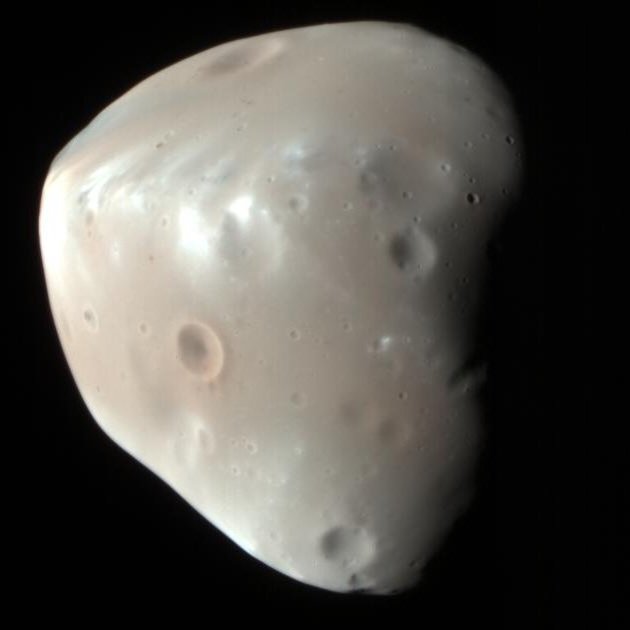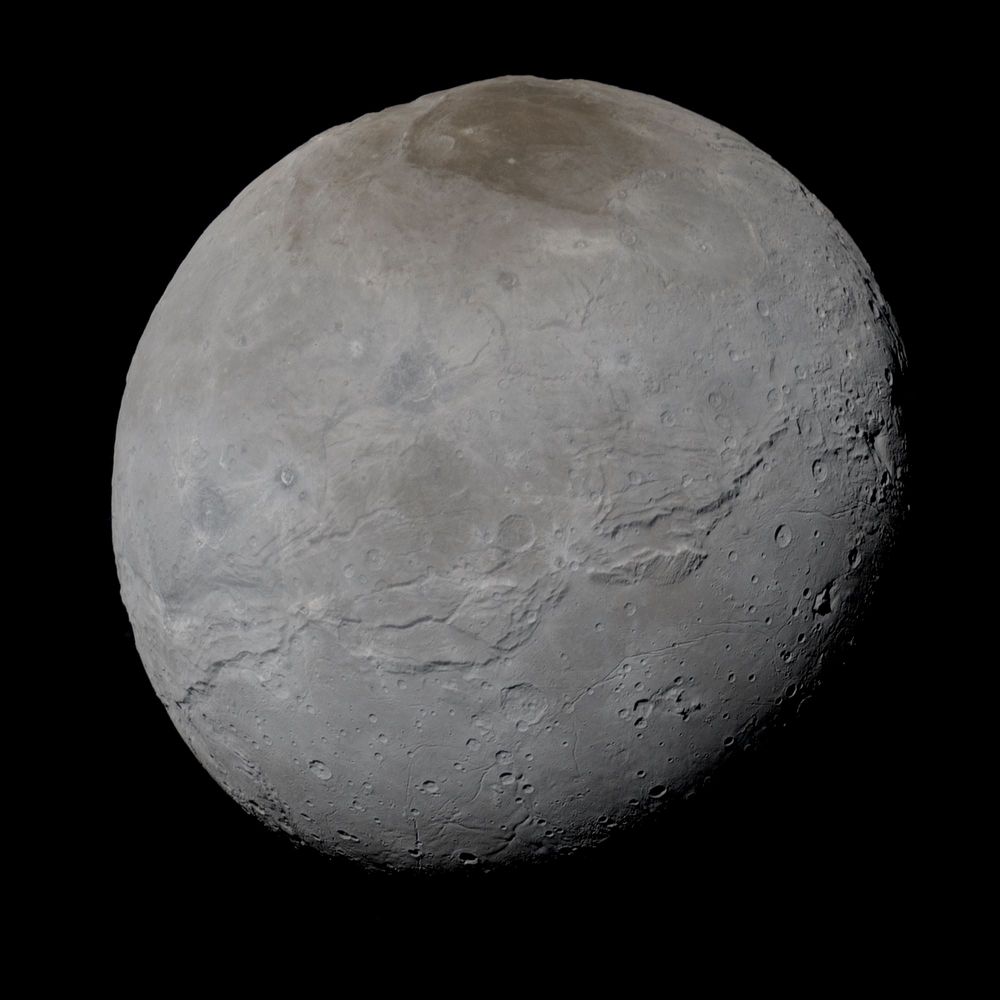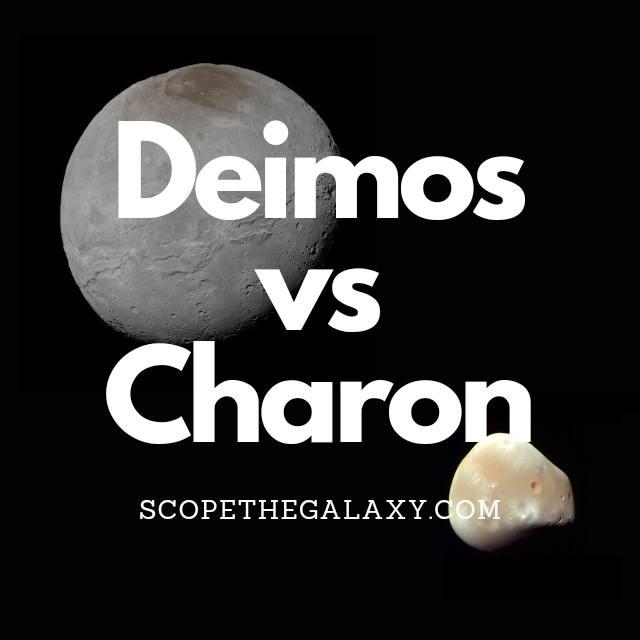*This post may contain affiliate links. This means we may make a commission if you purchase an item using one of our links*
The main differences between Deimos and Charon are that Deimos orbits Mars while Charon orbits Pluto, Deimos is far smaller with a diameter of 12.4km while Charon’s diameter is 1,212km and Charon has a more spherical shape to its body unlike Deimos which is not.
There are various other differences between these two, so continue reading for a more in-depth look at both moons along with their similarities and differences below.
What Is The Moon Deimos?
Table of Contents

Deimos is the smaller and outermost of the two moons of Mars, named after the Greek God of dread and terror (the brother of Phobos). This satellite was also discovered by American astronomer Asaph Hall just five days before Phobos (12th August 1877).
Scientists like Johannes Kepler had put forward theories for the existence of these moons many years before they were discovered. Their calculations were based on the fact that the planets on either side (Earth and Jupiter) possessed one and four moons, respectively.
Still, none were discovered until the 19th century. One of the main reasons for this is that the tiny size of Phobos and Deimos, combined with an exceptionally close orbit to their planet, means that the glare of Mars often obscures our view of them.
Phobos measures just 15 x 12 x 11 km and completes an orbit of Mars once every 30 hours.
This tiny moon is also a heavily cratered landscape shaped by the impact of asteroid collisions over time. However, the material thrown up from these impacts doesn’t appear to have landed back on the moon’s surface as it usually would. This could be because the lack of gravity on Phobos allowed the ejected material into space.
The surface gravity on Deimos is just 0.003 m/s^2 (compared to 9.807 m/s^2 on Earth), which means the average gravitational pull of Deimos is only 0.003 m/s. With only 1/2500th of Earth’s gravity, you would need a tether to walk on this rocky moon, or every step would put you at risk of achieving escape velocity and launching yourself into space.
The composition of Deimos is similar to Phobos, suggesting that it might also be a captured asteroid. Its surface is very dark gray and has an albedo of around 0.07, meaning it reflects just 7% light (about half of the light Earth’s moon can reflect).
What Is The Moon Charon?

Charon is the largest of Pluto’s moons, first discovered on 22nd June 1978. The surface of this icy world is frozen with nitrogen and methane ice; it may also hold some water ice. While Pluto possesses a reddish hue, Charon is closer to a neutral shade of grey; this suggests the two bodies have different compositions.
Scientists named this moon after the mythical ferryman, Charon, who once carried souls across the Acheron river. This river is one of five legendary rivers that could lie beneath the surface of Pluto.
The formation of Charon remains something of a mystery to scientists. However, this moon may have formed around 4.5 billion years ago when an object traveling at immense speed collided with Pluto. Its average distance from the Sun is approximately 3.6 billion km.
Charon is almost half the size of its planet at 1,212km, where scientists refer to these two bodies as a “double dwarf planet system,” and the chilly temperatures vary from minus 23 to minus 258 degrees Celsius.
Charon takes 153 hours to orbit its planet at an average distance of 19,640km, and it is tidally locked, meaning the same side of the moon always faces Pluto. Pluto also experiences a tidal lock to Charon, so the same two sides always face one another.
Among the fascinating features of this ice moon are the ice volcanoes that could exist on the surface. Observations from the Gemini observatory suggest that Charon could have a form of cryovolcanism known as ice-particle geysers.
The frigid world also has a canyon between seven and nine kilometers deep. (To put that into perspective, Mount Everest has a height of 8.8km).
Similarities Between Deimos And Charon
As both are natural satellites, Charon and Deimos do share a few similarities, which includes the following:
- Both have a rocky, terrestrial surface.
- Neither have rings surrounding them.
- Both are tidally locked to their planet.
- Both orbit their planet in an elliptical pattern.
- Neither have a magnetic field.
- Neither have tectonic plates
- Both entities have practically no atmosphere
Differences Between Deimos And Charon
As for the differences between the two, they include the below.
- Deimos orbits Mars whilst Charon orbits Pluto.
- Charon is a spherical shape while Deimos is not.
- Charon has a diameter of 1,212km whilst Deimos has a diameter of 12.4km.
- A day on Deimos takes 30 hours whilst a Charon day takes 153 hours.
- It takes Deimos 30 hours to orbit Mars and around the Sun in 687 days whilst Charon orbits Pluto in 153 hours whilst it orbits the Sun in 247.78 years.
- Deimos’ temperature ranges between -4 to -112 degrees Celsius whilst Charon’s is between -23 to -258 degrees Celsius.
- Charon’s density is 1.71 g/cm³ whilst Deimos density is 1.47 g/cm³.
- Charon mass is 1.58 × 10^21 kg whilst Deimos’ mass is 1.4762 × 10^15 kg.
- Deimos’ gravitational strength is 0.003 m/s² whilst Charon’s is 0.288 m/s².
- Charon orbits Pluto at an average distance of 19,640km whilst Deimos is 24,680km away from Mars.
- Charon has a central core while Deimos does not.
Summary
Both Deimos and Charon are natural satellites, are tidally locked to their respective planets and are rock based however, they are still unique when you breakdown their features
Whether it be in regards to their mass, size, physical shape, gravitational strength, how they orbit their respective planets and more, Charon and Deimos are still very distinct celestial bodies in their own right.

